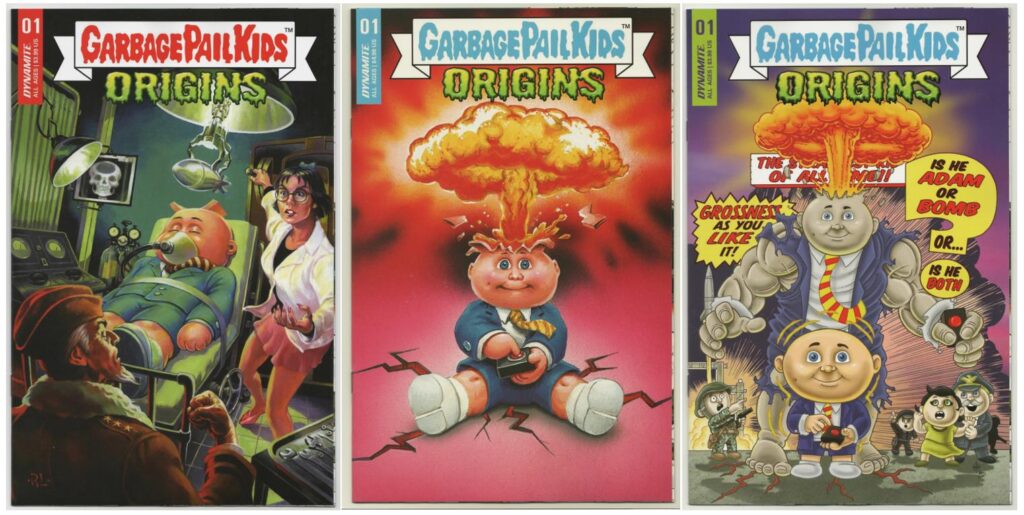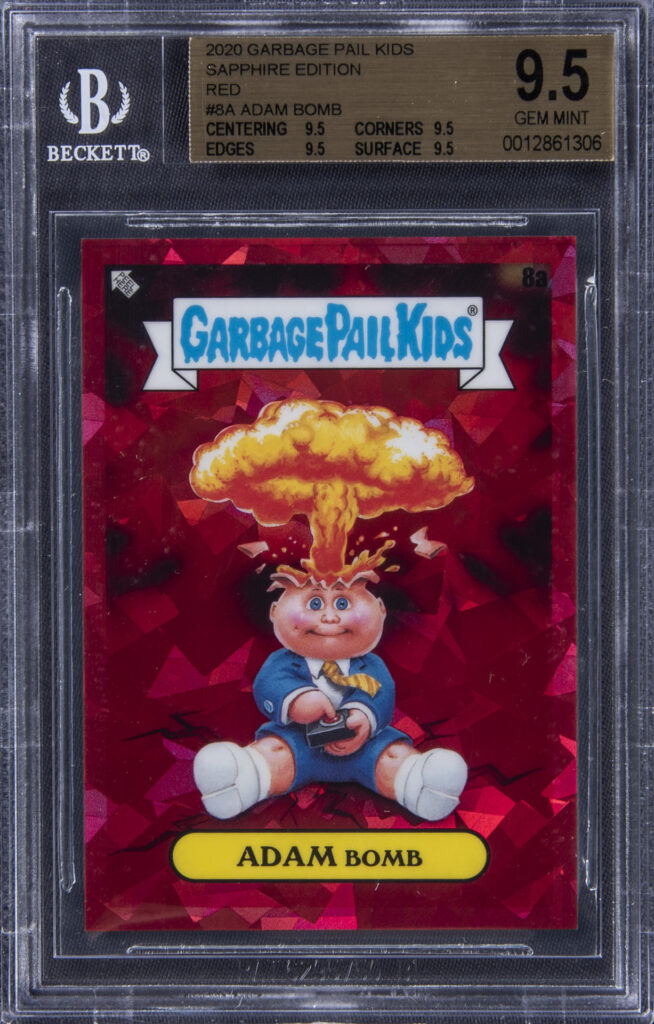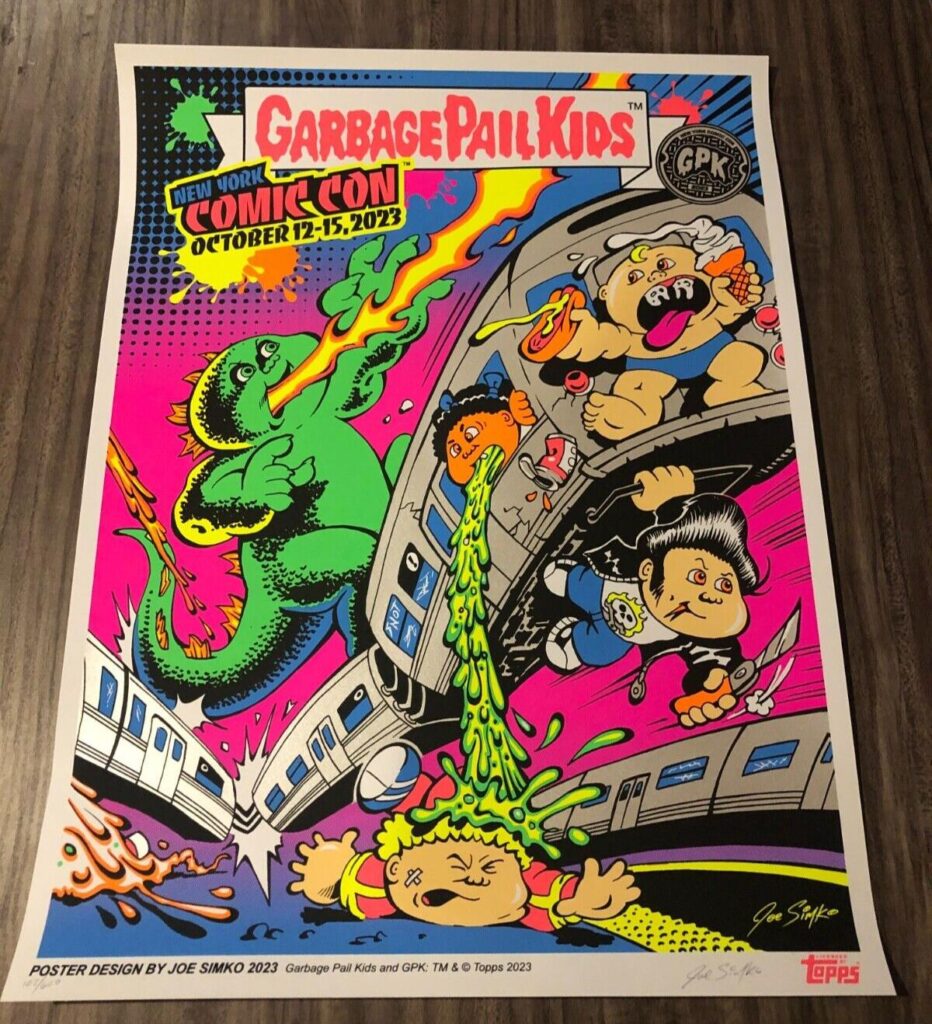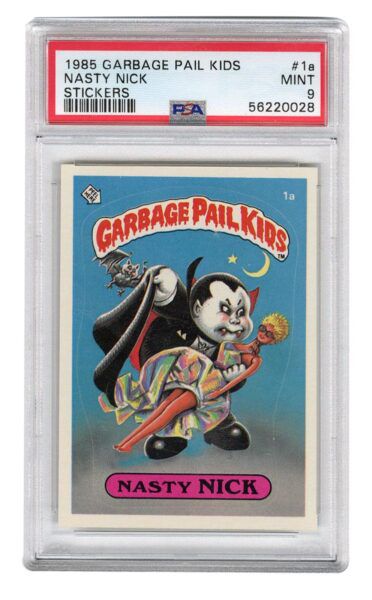#Garbage #Pail #Kids #Making #Comeback #WorthPoint

Words like “horrible,” “grotesque,” and “disgusting” have been used to describe a certain colorful series of collectible sticker cards first produced by Topps in 1985. Known collectively as the Garbage Pail Kids (GPK), each one featured a drawing of a baby-like figure and usually involved snot, vomit, and blood in varying quantities. The reverse of some cards even featured joke permission slips. These allowed children to cheat on tests, stay up late, and even pay half-fare on the bus by boarding it using only their knees.
Despised by parents and teachers, the Garbage Pail Kids cards proved an instant smash hit with children. Today, they are making a comeback, and some cards from the original sets can fetch four-figure sums.
Playground Contraband: The History
In the early ’80s, a craze swept across the length and breadth of America—the Cabbage Patch Kids. Consisting of a series of loveable cloth dolls with plastic heads, each one had a delightfully mushy backstory. In the run-up to Christmas 1983, the so-called Cabbage Patch riots occurred in stores nationwide when customers scrambled (sometimes violently) to purchase them as presents.
Meanwhile, the Topps trading card company had a long history of parodying contemporary media in its products. Back in the 1960s, its Wacky Packages cards entranced kids by poking fun at a bunch of beloved TV shows. The enormously popular Adam West Batman series was chief in the firing line (most notably with a card featuring Batman using his Bat-Toilet).
Amid Cabbage Patch fever, Topps execs felt it only fair to give the overly cuddly toys the Wacky Packages treatment. Art Spiegelman (who later went on to win a Pulitzer Prize for his World War II graphic novel, Maus) became the driving force behind the first printings of the Garbage Pail Kids. Topps veteran John Pound drew most of the early designs.

Due to pitch-perfect marketing, the GPK cards became an underground sensation and were rapidly changing hands at exorbitant rates. Cabbage Patch Fever was quickly replaced by Garbage Pail Kids Fever.
One particularly offensive card—Baby Abie—was rejected from the Series 3 print run. It featured a Garbage Pail Kid rendition of President Abraham Lincoln with bullet holes in his head and iconic top hat. Due to the sensitive nature of the card, Topps refused to print it in 1985, though Baby Abie was later issued as part of the Flashback Series. Topps executives also steered well clear of any illustrations mocking religion. A drawing depicting one of the kids receiving a set of GPK cards as if they were the Ten Commandments was quickly shelved by execs.
In the spring of 1986, Original Appalachian (the makers of Cabbage Patch Dolls) filed a lawsuit against Topps for copyright infringement. Rather than fight it out in court, Topps decided to settle and gave assurances that the artwork would change in future cards. This is why the later print runs have a different art style to the originals. It also explains why the early cards are much more sought after than the later releases.
In 1987, an ill-timed Garbage Pail Kids movie was released. Audiences wisely chose to stay away, and the film barely made a return on its estimated $1 million budget. By 1989, the Kids had run their course, and Topps decided to cancel the planned Set 16 release due to declining interest. But the ne’er-do-well kids from the wrong side of the tracks would not die easily.
The year 2003 saw the release of the “modern” Garbage Pail Kids. While the art style was noticeably different, the controversial intent of the cards remained the same. Even today, the Garbage Pail Kids remain popular and are still parodying everything from presidents to the latest Hollywood blockbusters. A 2023 card from the Entertainment Blend Set has a glum-looking Robert Oppenheimer alongside the classic 1985 character Adam Bomb as the Los Alamos nuclear explosion.

Valuable Garbage Pail Kids Cards
Every card from the 1985 Series 1 print run is in demand on the modern market if it is not crumpled beyond recognition.
When most people of a certain age think about the Garbage Pail Kids, it is the atomically explosive Adam Bomb that immediately comes to mind. With his finger firmly pressed down on the self-destruct button, a colossal fiery mushroom cloud springs from the top of his skull. Adam featured in much of the early advertising and has since become a poster boy for the Kids. Because of his enduring fame and the striking visuals on his card, Adam Bomb usually fetches the most money today—sometimes north of $7,000.
The next most valuable card, also hailing from the Series 1 1985 print run, is the very first Garbage Pail Kids card ever produced. Nasty Nick draws clear inspiration from Count Dracula as he stands ready to sink his teeth into a pliant victim. A PSA-graded 9 can fetch north of $2,000, though the card tends to sell for a few hundred dollars. However, a PSA-graded Mint 10 (Gem) did sell for nearly $20,000 a couple of years back.
Cards printed after 2003 are generally less valuable than classic sets. An exception is the Chrome Series. In 2013, Topps reissued the Series 1 cards (including favorites Adam Bomb and Nasty Nick) with a shiny silver background. Of the Chrome release, it is the special 2020 Sapphire Adam Bomb card that consistently nets high profits for sellers. One recently sold with a Beckett grade of 9.5 for over $7,000.

A Gross Hobby?
Many of the original GPK drawings lack the political awareness of modern times (anyone remember Schizo Fran from the Series 2 print run?), but the cards still endure today because of their rebellious streak.
The initial print run of the Kids sold in June 1985 for a mere twenty-five cents per pack. Anyone who bought some as a child and still has them tucked away at the bottom of an old box in the garage might be looking at a multi-thousand percent return today.
The GPK remain popular for the same reason they were a hit in the 1980s—their power to cause controversy. While they may not have quite the same shock value in our modern world, there is still something innately rebellious about owning the GPK. Historically, card collecting has been dominated by sports. But as the new generation of collectors gradually broaden their horizons, it is the non-sports cards that will eventually dominate the market. The growing popularity of Magic: The Gathering and Pokémon (among many other franchises) represents the future. Young collectors with cash to splash don’t want another reissue of a Mickey Mantle card—they demand the cultural icons of their childhood. This means the Garbage Pail Kids won’t be running dry of snot anytime soon.
Matthew Doherty is a writer, editor, and teacher specializing in all things history-related. His work has been published in the UK Defence Journal, the Small Wars Journal, and The Collector. He holds an MSc from the University of Edinburgh and a BA from the University of Leeds. In his spare time, he also writes science fiction stories.
WorthPoint—Discover. Value. Preserve.




